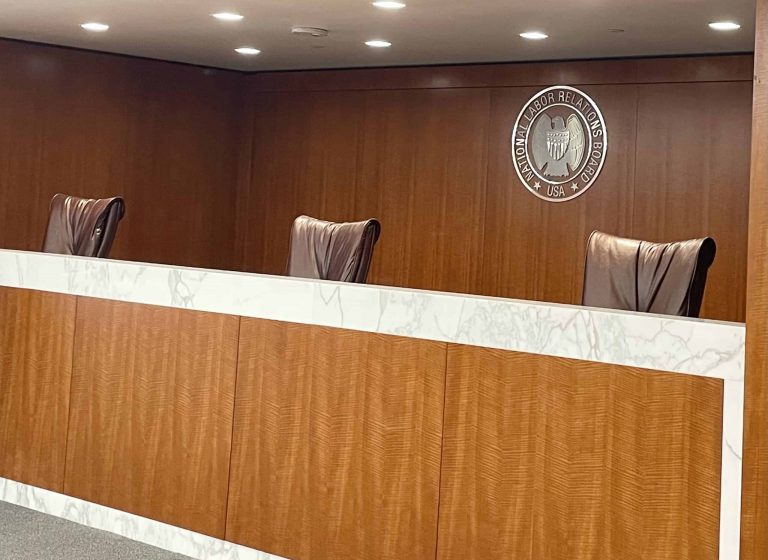
Kevin Vazquez is a staff attorney at the International Brotherhood of Teamsters. He graduated from Harvard Law School in 2023. The opinions he expresses on this blog are his own and should not be attributed to the IBT.
Last week, in NLRB. v. Constellium Rolled Products Ravenswood, LLC, a divided Fourth Circuit panel, led by two Trump appointees, held that it does not have jurisdiction to enforce an NLRB “consent order” — a Board order issued against a consenting party that has entered a settlement agreement — because the parties lack “adverseness,” meaning the issue presents no “case or controversy” fit for judicial resolution under Article III of the Constitution. This ruling, as the lone dissenter pointed out, is a stunning break with precedent, given that no court before has even questioned — let alone rejected — its jurisdiction to hear these cases. And the Supreme Court itself has given its implicit approval to the practice in multiple instances in which it has considered such orders without questioning “adverseness.”
The NLRB is in many ways a rarity as compared to other federal agencies. One such peculiarity is that the Board’s orders, unlike those of most other federal agencies, are not self-executing. This means that a Board’s order has no binding legal effect when issued; the NLRB must petition a court of appeals for a judicial order enforcing it for compliance to become obligatory under § 10(e) of the National Labor Relations Act. In part because of the Board’s “curious impotence” in this regard, it has a longstanding practice of petitioning courts to enter consent judgments against parties that have violated the NLRA after the Board has reached a settlement agreement with them, even if they have not yet violated the Board’s order. Otherwise, the employer could violate the Board’s order with impunity, regardless of its guarantees not to do so. Nonetheless, the Fourth Circuit ruled that it lacks jurisdiction to enforce such agreements because doing so would have no “real-world consequences.”
The facts of the case are straightforward and unremarkable. Constellium Rolled Products Ravenswood employs members of the United Steelworkers, which filed unfair labor practice charges against the company for its conduct during a labor dispute in 2019 and 2020. The Board’s General Counsel found merit in the allegations and issued a complaint against the company. But rather than proceed through the agency adjudication process, Constellium and USW settled their dispute by entering a stipulation agreement. Under the terms of the agreement, Constellium conceded that it had violated the NLRA and agreed to “immediately comply with the provisions of the order” upon the Board’s approval. It also — critically — agreed to waive all defenses and consent to entry of a judgment against it when the Board sought judicial enforcement of the order.
One week after approving the settlement, the Board petitioned the Fourth Circuit to enter a consent judgment enforcing the order against Constellium. It did not assert that the company had violated the order but rather argued that it was “entitled to enforcement” because the company had “expressly consented” to the judgment in the stipulation. The company upheld its end of the bargain, stating in its response that it “consent[ed] to the entry of judgment and enforcement of the Board’s order.” In short, as the court characterized it, the NLRB and the employer “came together, hand-in-hand” to ask it “to enter a judgment binding Constellium to the promises it made in the settlement — without disagreement or a violation of the Board’s order.” This, according to the court, could not be done.
The problem, the court said, was one of “adverseness”: two parties must be “adverse” in order for the dispute to present a justiciable “case or controversy” under Article III. This requirement does not mean that the parties need “disagree about everything,” but they must at least “retain adverse interests in the litigation’s outcome.” For two parties to have adverse interests — which, the court contended, is the “minimum adverseness threshold” required under Article III — the requested judicial action must have “real-world consequences” and “real meaning for the parties.”
Although conceding that many prior courts, including the Supreme Court, had approved the Board’s consent orders before without ever mentioning any “adverseness” problem, the court held that the parties had insufficiently adverse interests for two reasons: (1) they settled the dispute before the NLRB, and (2) their settlement included a promise from the charged party not to contest enforcement before the court. Any adverseness that at one time had existed between the parties was thus “extinguished,” and the consent judgment sought by the Board would have merely maintained the status quo by requiring the company to do what it had already agreed to do and was already doing. In such circumstances, the court concluded, the litigation “has no real meaning,” and adverseness — and, therefore, federal court jurisdiction under Article III — is “lacking.”
In the court’s view, the critical point was that “no dispute existed when the Board filed its petition” for judicial enforcement of the order, since Constellium did not deny any of the allegations against it. Thus, the controversy ended when the Board issued its order, and there was “nothing for [the] court to do that would have real consequences in the world.” This is, practically speaking, incorrect, as the dissent notes. Because the Board’s orders are not self-executing, a court’s enforcement order would have real consequences: Constellium is not legally bound by the Board’s order until it is judicially enforced, so judicial enforcement “would have the real-world effect of consummating the administrative process that Congress has carefully set up, entitling the Board and the complaining union to compel Constellium’s compliance upon pain of contempt.”
Moreover, there is a lengthy catalog of case law establishing that “compliance with a Board order does not deprive the Board of an interest in enforcing that order” and that an employer’s “compliance with an order of the Board” does not “deprive the Board of its opportunity to secure enforcement from an appropriate court.” Because a Board order “imposes a continuing obligation,” it is “entitled to have the resumption of the unfair practice barred by an enforcement decree.” For this reason, the NLRB certainly has sufficient “interest” in the enforcement of its order to provide federal court jurisdiction — it has an interest in the case’s outcome because it has an interest in preventing future labor law violations, as the dissent rightly observes. There is also, as the majority acknowledges, “a long history . . . of courts blessing consent decrees,” comparable agreements that arise outside of the labor context, and Supreme Court precedent has stated baldly that “a judgment upon consent is a judicial act.” But none of this was enough to convince the majority.
In any event, the ruling on its face does not appear to impose any particularly challenging obstacles to the NLRB. The dissent pointed out that the Board could evade any similar non-justiciability problems in the future by merely declining to compel employers to preemptively waive their defenses to enforcement or by making agreements conditional on judicial enforcement as well as Board approval (rendering them more analogous to consent decrees, which are inoperative prior to judicial approval), thus maintaining the “adverseness” of the parties. Nonetheless, despite the apparent limitations of its holding, this decision needlessly disturbed one of the NLRB’s well-settled practices, which may bode poorly for the agency as it seeks to reinvigorate its enforcement of the NLRA.









Daily News & Commentary
Start your day with our roundup of the latest labor developments. See all
July 14
More circuits weigh in on two-step certification; Uber challengers Seattle deactivation ordinance.
July 13
APWU and USPS ratify a new contract, ICE barred from racial profiling in Los Angeles, and the fight continues over the dismantling of NIOSH
July 11
Regional director orders election without Board quorum; 9th Circuit pauses injunction on Executive Order; Driverless car legislation in Massachusetts
July 10
Wisconsin Supreme Court holds UW Health nurses are not covered by Wisconsin’s Labor Peace Act; a district judge denies the request to stay an injunction pending appeal; the NFLPA appeals an arbitration decision.
July 9
the Supreme Court allows Trump to proceed with mass firings; Secretary of Agriculture suggests Medicaid recipients replace deported migrant farmworkers; DHS ends TPS for Nicaragua and Honduras
July 8
In today’s news and commentary, Apple wins at the Fifth Circuit against the NLRB, Florida enacts a noncompete-friendly law, and complications with the No Tax on Tips in the Big Beautiful Bill. Apple won an appeal overturning a National Labor Relations Board (NLRB) decision that the company violated labor law by coercively questioning an employee […]